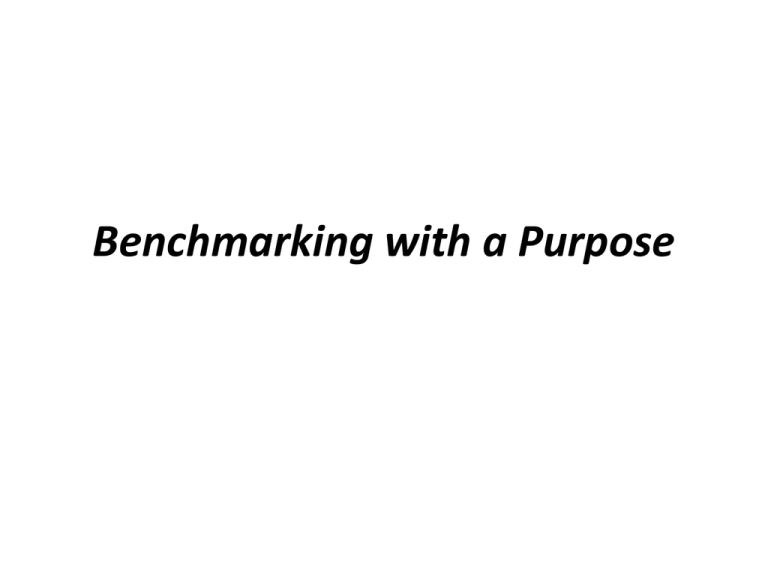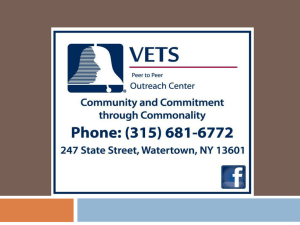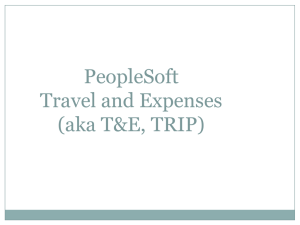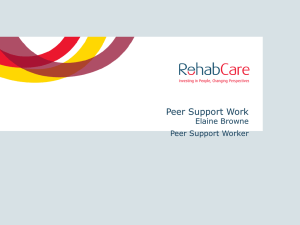Credit Union Sustainability: A long term model for success.
advertisement

Benchmarking with a Purpose Ask 50 people what is important and what should be measured. You will get 50 different answers. 2 Objective: Develop a benchmarking framework to guide leaders toward key aspects about strategies and operations. 3 Objective is not: Detailed process metrics Detailed market analytics (narrowly focused; difficult to collect/compare) Internal policy Regulatory requirements (no universal standards; subject to interpretation) 4 Benchmarking must be a part of your planning process. Difficult to set a course, and monitor environment without a reference point. 5 Why ROA is a horrible benchmark of success… 6 Singular Profit Mandate Maximize Return 7 Credit Union Dual Mandate Minimize ROA Maximize ROA Provide tangible benefit to members Stay adequately capitalized 8 Priority #1 Should Be… Credit Union Sustainability • Long Term Survival/Prosperity • Recurring Value for Members • Job Security for Employees 9 Expense Growth Capital Growth (ROE) Industry Dynamics Credit Losses Circle of Life or Spiral of Death Balance Sheet Growth Net Revenue Engine 10 Expense Growth Slow Death Capital Ratio Capital Growth (ROE) Credit Losses 10.0% 9.6% 9.3% 8.9% 8.6% 8.3% Now +1 Yr +2 Yrs +3 Yrs +4 Yrs +5 Yrs Balance Sheet Growth Net Revenue Engine 11 Expense Growth Sustainability Capital Ratio Capital Growth (ROE) Credit Losses 10.0% 10.0% 10.0% 10.0% 10.0% 10.0% Now +1 Yr +2 Yrs +3 Yrs +4 Yrs +5 Yrs Balance Sheet Growth Net Revenue Engine 12 Expense Growth Prosperity Capital Ratio Capital Growth (ROE) 10.0% 10.3% 10.7% 11.0% 11.2% 11.5% Credit Losses Now +1 Yr +2 Yrs +3 Yrs +4 Yrs +5 Yrs Balance Sheet Growth Net Revenue Engine 13 Expense Growth Capital Growth (ROE) Grow Capital Faster than Assets or Die! Balance Sheet Growth Credit Losses Net Revenue Engine 14 Benchmarking requires everyone on the “same sheet of music” 15 Balance Sheet Mapping (Simple Example) Assets Loans Surplus Funds Loan Loss Reserve (ALLL) Non-Earning Assets Liabilities & Equity (Net Worth) Relationship Funding Rate-Sensitive Funding Other Liabilities Equity Capital (Net Worth) 16 Income Statement Mapping (Simple Example) Net Revenue Interest Income Interest/Dividend Expense Non-Interest Income Net Revenue ROA Top line ROA. Operating Expense Personnel, Premise & Other Operating Expense Surplus before Provision ROA after operating expense. Credit Loss Expense Provision for Loan Loss Expense Surplus after Provision ROA after credit loss expense. Extraordinary Items Unusual income/expense and gains/losses Income Taxes As applicable Net Income ROA after all items. 17 Growth Sustainability Benchmarks Product Mix Interest Rates Operating Expense Capital Growth (ROE) ROE Must Meet or Exceed Asset Growth Credit Losses Capital Adequacy 18 Growth Key Benchmarks Include… Balance Growth Loans as Percentage of Assets Product Mix Relationship Funding as Percentage of Assets Rate Sensitive Funding as Percentage of Assets Interest Rates Operating Expense Non-Interest Income as Percentage of Assets Offer Rate: Loans Yield: Surplus Funds Offer Rate: Relationship Funding Offer Rate: Rate Sensitive Funding Credit Losses Capital Adequacy 19 The battle is NOT won or lost on the income statement; it is won or lost on the balance sheet. Income statement is what has happened; Balance sheet is what is going to happen. Where do you want to go? 20 Establish Target Product Mix 100% 90% Product Mix: Percentage of Assets 1.50% Target/Peer 80% 1.10% 70% 1.00% 65% 60% 55% 50% 40% 35% 30% 0.50% 20% 10% 0% 0.00% Rate Senstive Lowest Relationship Loans Strategic Value Non-Int Inc Highest 21 Chart Current Product Mix 100% 90% Product Mix: Percentage of Assets 1.50% CU 80% 1.10% 70% 1.00% 65% 60% 55% 50% 40% 35% 30% 0.50% 20% 10% 0% 50% 40% 55% 0.90% Rate Senstive Relationship Loans Non-Int Inc 0.00% 22 Identify Product Mix Gaps 100% 90% CU Product Mix: Percentage of Assets 1.50% Target/Peer 80% 1.10% 70% 1.00% 65% 60% 55% 50% 40% 35% 30% 0.50% 20% 10% 50% 40% 55% 0.90% Rate Senstive Relationship Loans Non-Int Inc 5.6 Years Away 4.3 Years Away 5.1 Years Away 0% Years to Target at 5% Growth Rate 0.00% 23 Understand Implication of Gaps 100% 90% 80% 1.50% Product Mix: Percentage of Assets 4.25% 4.10% CU 4.00% Target 1.10% 70% 1.00% 65% 3.75% 60% 55% 50% 75 bps 3.50% 40% 35% 0.50% 30% 3.25% 20% 10% 0% 50% 40% Rate Sensitive Relationship 55% 0.90% Loans Non-Int Inc 0.00% 3.00% 3.35% NR ROA Improving product mix improves ROA by 75 bps 24 Establish Target Offer Rates 8.00% Offer Rates CU Peer 6.00% 5.25% 4.00% 2.00% 1.10% 1.00% 0.20% 0.00% Rate Sensitive Relationship Investments Loans Current 1.25% 0.20% 1.00% 5.00% Target/Peer 1.00% 0.20% 1.10% 5.25% Variance 0.25% 0.00% (0.10%) 0.25% 25 Growth Product Mix Interest Rates Operating Expense Key Benchmarks Include… Efficiency Ratio Credit Losses Total Expense / Activity Balance Activity Balance / FTE Activity Balance / Branch Capital Adequacy 26 Efficiency Ratio Efficiency Ratio Ranges • Efficiency Ratio Operating Expense as a percentage of net revenue $75 Operating Expense / $100 Net Revenue = 75% Efficiency = 25% Remaining to cover credit losses and provide capital growth > 100% 90-100% Failure is Imminent Slow Death 80-90% Skating on Thin Ice 75-80% Surviving 70-75% Thriving 60-70% Highly Productive <60% Extremely Productive (or getting greedy) 27 Activity Balance • Loan Balance, plus • Relationship Funding Balance, plus • Non-Interest Income Equivalent Asset Balance (Non-Interest Income / Net Interest Margin) If net interest income was an asset, how big would it be? 28 Activity Balance Benchmarks • Expense as Percentage of Activity Balance (expense leverage into strategic drivers) • Activity Balance per Branch (branch network leverage) • Activity Balance per FTE (human leverage) 29 Operating Expense Productivity Metrics CU CU Peer CU Peer Peer Peer CU Efficiency Ratio Op Exp / Activity Bal Activity Bal / Branch Activity Bal / FTE 30 Growth Product Mix Interest Rates Operating Expense Credit Losses Key Benchmarks Include… Leading Indicators: Underwriting Capital Adequacy Leading Indicators: Post Underwriting Lagging Indicator: Net Charge-Offs Self Insurance Fund: Loan Loss Reserve 31 Asset Quality Pipeline Credit Quality Metrics CU CU CU Peer Peer Peer Peer Peer CU CU Avg Credit Score Delinq 0-30 Delinq 30-90 Net Charge-Offs Loan Loss Reserve 32 Growth Product Mix Interest Rates Operating Expense Credit Losses Key Benchmarks Include… Capital Adequacy Capital / Total Assets Risk Based Net Worth Requirement 33 Growth Peer Groups Thoughts… • Rule #1: Perfect peer does not exist (Sasquatch) Product Mix Interest Rates Operating Expense Credit Losses Capital Adequacy • Population: 10-30 Peers • Span of Data 3-5 Yr History (NEVER Annualize Current Year) • • • • • Asset/Branch Peer Geographic Peer Charter Peer Custom Peer Mixed Peer • Tradeoffs exist; can’t be best at everything. 34 Growth Product Mix Interest Rates Operating Expense Local/regional peer may be best. Industry best practice peer (indifferent to location) Local/regional peer may be best. Equivalent asset/branch peer may be best. Credit Losses Local/regional peer may be best. Capital Adequacy Local/regional peer may be best. 35 Sample Benchmarking Scorecard Top Middle Bottom Loan Growth Growth Relationship Funding Growth Member Growth Net Revenue ROA Product Mix Non-Interest Income Loans Relationship Funding Interest Rates Net Interest Margin Loan Yield; Offer Rate Surplus Funds Yield Operating Expense Relationship Funding Offer Rate Rate Sensitive Funding Cost; Offer Rate Efficiency Ratio Total Expense / Activity Balance Credit Losses Activity Balance / Branch Activity Balance / FTE Delinquencies Capital Adequacy Net Charge-Offs Loan Loss Reserve Capital Ratio Risk Based Net Worth Requirement 36 Member Value Assessment • Member value is created when: – Product mix is stronger than peer/target – Interest rates are favorable to members (ROA drag) – Productivity is greater than peer – Credit losses are fewer than standard(s) 37 1.20% Return on Assets 1.00% Return on Assets 1.00% 0.80% 0.70% 0.60% 0.40% 0.35% 0.25% 0.20% 0.15% 0.00% Peer ROA CU ROA Creating Producing ROA Member Benefit Lift Potential Improvement Opportunity 38 Member Value Assessment 1.20% 1.00% Return on Assets 1.00% 0.80% 0.70% 0.60% 0.40% 0.35% 0.25% 0.20% 0.15% 0.00% Peer ROA CU ROA Creating Producing ROA Member Benefit Lift Potential Improvement Opportunity 39 Member Value Assessment 1.20% 0.35% 0.35% Return on Assets 1.00% 0.80% Reduce member favorable pricing. 0.70% 0.70% 0.65% 0.60% 0.40% 0.25% 0.20% 0.15% 0.00% Peer ROA CU ROA Creating Producing ROA Member Benefit Lift Potential Improvement Opportunity 40 Benchmarking with a Purpose




